Project Management Methodologies: Agile Scrum vs PMBOK
VerifiedAdded on 2021/04/21
|8
|1495
|56
Report
AI Summary
This report delves into the realm of project management methodologies, focusing on the comparison between Agile Scrum and the Project Management Body of Knowledge (PMBOK). It begins by defining Project Management Methodology (PMM) as a crucial tool that guides project managers in achieving successful project outcomes, highlighting its role in managing project complexities and sizes. The report then emphasizes the importance of PMM in delivering services efficiently, resolving project challenges, reducing risks, increasing team support, and ensuring continuous improvement. A key section compares and contrasts Agile Scrum and PMBOK, discussing the flexibility and adaptability of Agile Scrum in today's business environment versus the rigidity of PMBOK. The report further explores the relationship between Agile Scrum and the project life cycle, outlining the phases involved and how Scrum facilitates iterative development and incremental delivery, particularly in software development projects. References are provided to support the analysis and findings presented in the report.
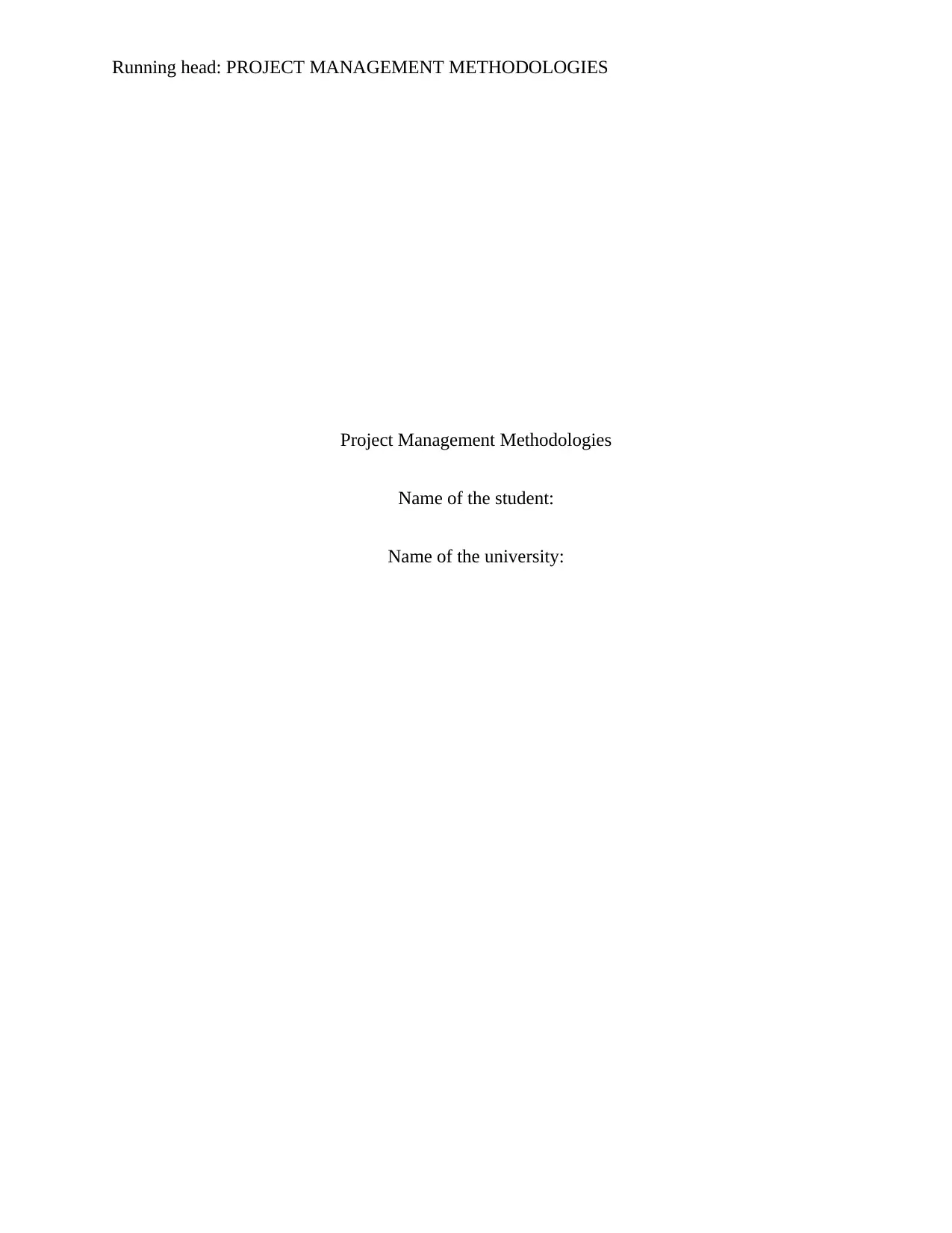
Running head: PROJECT MANAGEMENT METHODOLOGIES
Project Management Methodologies
Name of the student:
Name of the university:
Project Management Methodologies
Name of the student:
Name of the university:
Paraphrase This Document
Need a fresh take? Get an instant paraphrase of this document with our AI Paraphraser
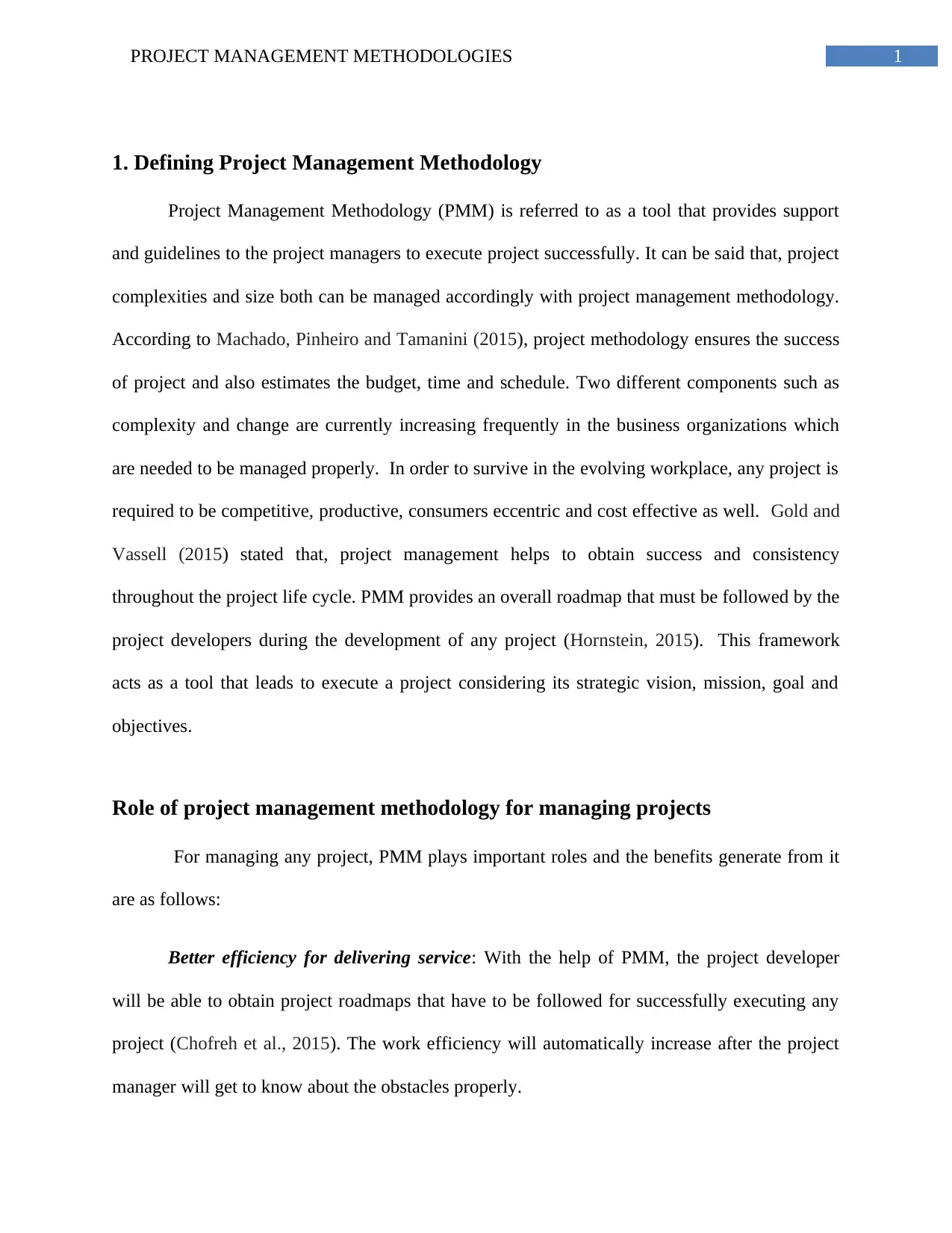
1PROJECT MANAGEMENT METHODOLOGIES
1. Defining Project Management Methodology
Project Management Methodology (PMM) is referred to as a tool that provides support
and guidelines to the project managers to execute project successfully. It can be said that, project
complexities and size both can be managed accordingly with project management methodology.
According to Machado, Pinheiro and Tamanini (2015), project methodology ensures the success
of project and also estimates the budget, time and schedule. Two different components such as
complexity and change are currently increasing frequently in the business organizations which
are needed to be managed properly. In order to survive in the evolving workplace, any project is
required to be competitive, productive, consumers eccentric and cost effective as well. Gold and
Vassell (2015) stated that, project management helps to obtain success and consistency
throughout the project life cycle. PMM provides an overall roadmap that must be followed by the
project developers during the development of any project (Hornstein, 2015). This framework
acts as a tool that leads to execute a project considering its strategic vision, mission, goal and
objectives.
Role of project management methodology for managing projects
For managing any project, PMM plays important roles and the benefits generate from it
are as follows:
Better efficiency for delivering service: With the help of PMM, the project developer
will be able to obtain project roadmaps that have to be followed for successfully executing any
project (Chofreh et al., 2015). The work efficiency will automatically increase after the project
manager will get to know about the obstacles properly.
1. Defining Project Management Methodology
Project Management Methodology (PMM) is referred to as a tool that provides support
and guidelines to the project managers to execute project successfully. It can be said that, project
complexities and size both can be managed accordingly with project management methodology.
According to Machado, Pinheiro and Tamanini (2015), project methodology ensures the success
of project and also estimates the budget, time and schedule. Two different components such as
complexity and change are currently increasing frequently in the business organizations which
are needed to be managed properly. In order to survive in the evolving workplace, any project is
required to be competitive, productive, consumers eccentric and cost effective as well. Gold and
Vassell (2015) stated that, project management helps to obtain success and consistency
throughout the project life cycle. PMM provides an overall roadmap that must be followed by the
project developers during the development of any project (Hornstein, 2015). This framework
acts as a tool that leads to execute a project considering its strategic vision, mission, goal and
objectives.
Role of project management methodology for managing projects
For managing any project, PMM plays important roles and the benefits generate from it
are as follows:
Better efficiency for delivering service: With the help of PMM, the project developer
will be able to obtain project roadmaps that have to be followed for successfully executing any
project (Chofreh et al., 2015). The work efficiency will automatically increase after the project
manager will get to know about the obstacles properly.
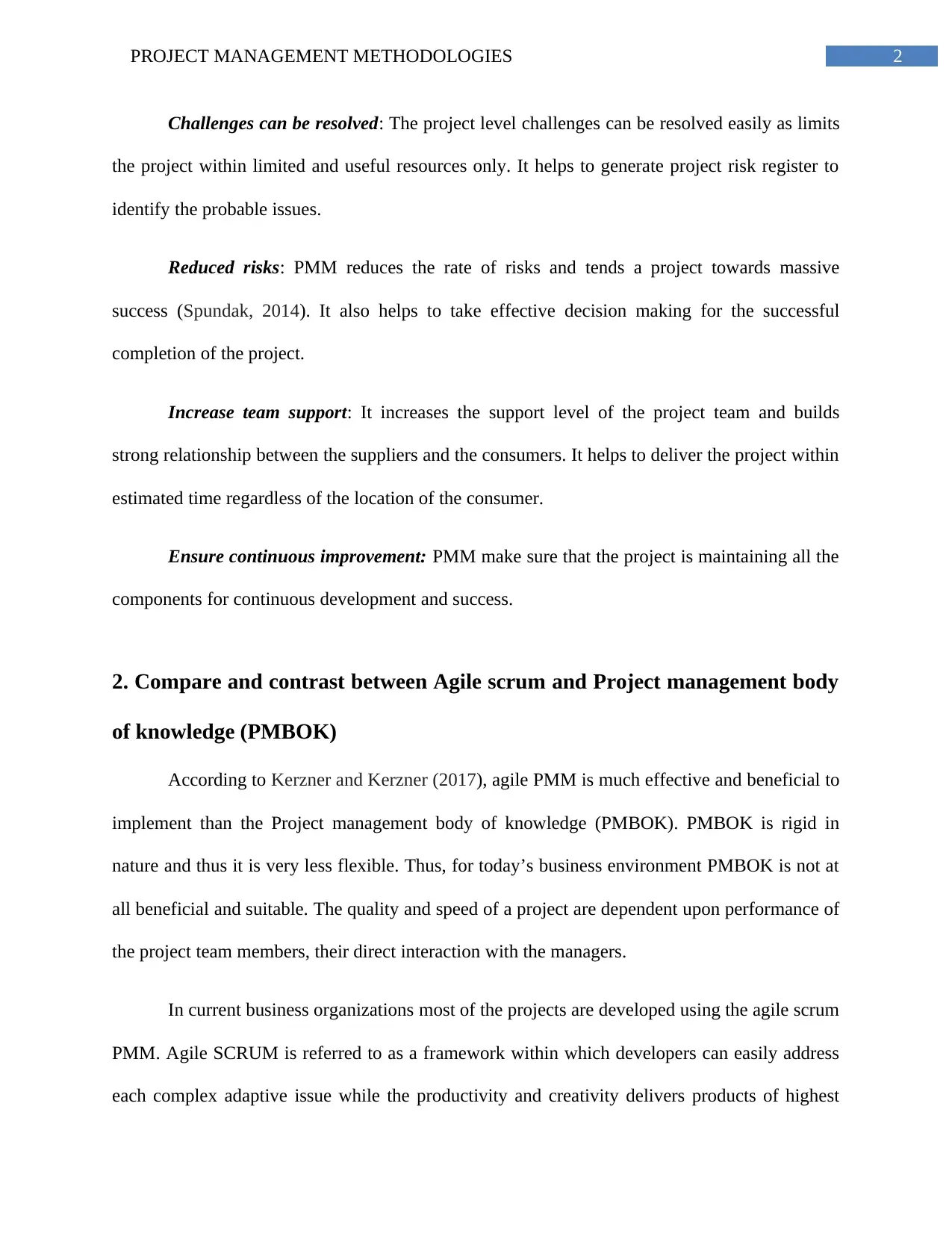
2PROJECT MANAGEMENT METHODOLOGIES
Challenges can be resolved: The project level challenges can be resolved easily as limits
the project within limited and useful resources only. It helps to generate project risk register to
identify the probable issues.
Reduced risks: PMM reduces the rate of risks and tends a project towards massive
success (Spundak, 2014). It also helps to take effective decision making for the successful
completion of the project.
Increase team support: It increases the support level of the project team and builds
strong relationship between the suppliers and the consumers. It helps to deliver the project within
estimated time regardless of the location of the consumer.
Ensure continuous improvement: PMM make sure that the project is maintaining all the
components for continuous development and success.
2. Compare and contrast between Agile scrum and Project management body
of knowledge (PMBOK)
According to Kerzner and Kerzner (2017), agile PMM is much effective and beneficial to
implement than the Project management body of knowledge (PMBOK). PMBOK is rigid in
nature and thus it is very less flexible. Thus, for today’s business environment PMBOK is not at
all beneficial and suitable. The quality and speed of a project are dependent upon performance of
the project team members, their direct interaction with the managers.
In current business organizations most of the projects are developed using the agile scrum
PMM. Agile SCRUM is referred to as a framework within which developers can easily address
each complex adaptive issue while the productivity and creativity delivers products of highest
Challenges can be resolved: The project level challenges can be resolved easily as limits
the project within limited and useful resources only. It helps to generate project risk register to
identify the probable issues.
Reduced risks: PMM reduces the rate of risks and tends a project towards massive
success (Spundak, 2014). It also helps to take effective decision making for the successful
completion of the project.
Increase team support: It increases the support level of the project team and builds
strong relationship between the suppliers and the consumers. It helps to deliver the project within
estimated time regardless of the location of the consumer.
Ensure continuous improvement: PMM make sure that the project is maintaining all the
components for continuous development and success.
2. Compare and contrast between Agile scrum and Project management body
of knowledge (PMBOK)
According to Kerzner and Kerzner (2017), agile PMM is much effective and beneficial to
implement than the Project management body of knowledge (PMBOK). PMBOK is rigid in
nature and thus it is very less flexible. Thus, for today’s business environment PMBOK is not at
all beneficial and suitable. The quality and speed of a project are dependent upon performance of
the project team members, their direct interaction with the managers.
In current business organizations most of the projects are developed using the agile scrum
PMM. Agile SCRUM is referred to as a framework within which developers can easily address
each complex adaptive issue while the productivity and creativity delivers products of highest
⊘ This is a preview!⊘
Do you want full access?
Subscribe today to unlock all pages.

Trusted by 1+ million students worldwide
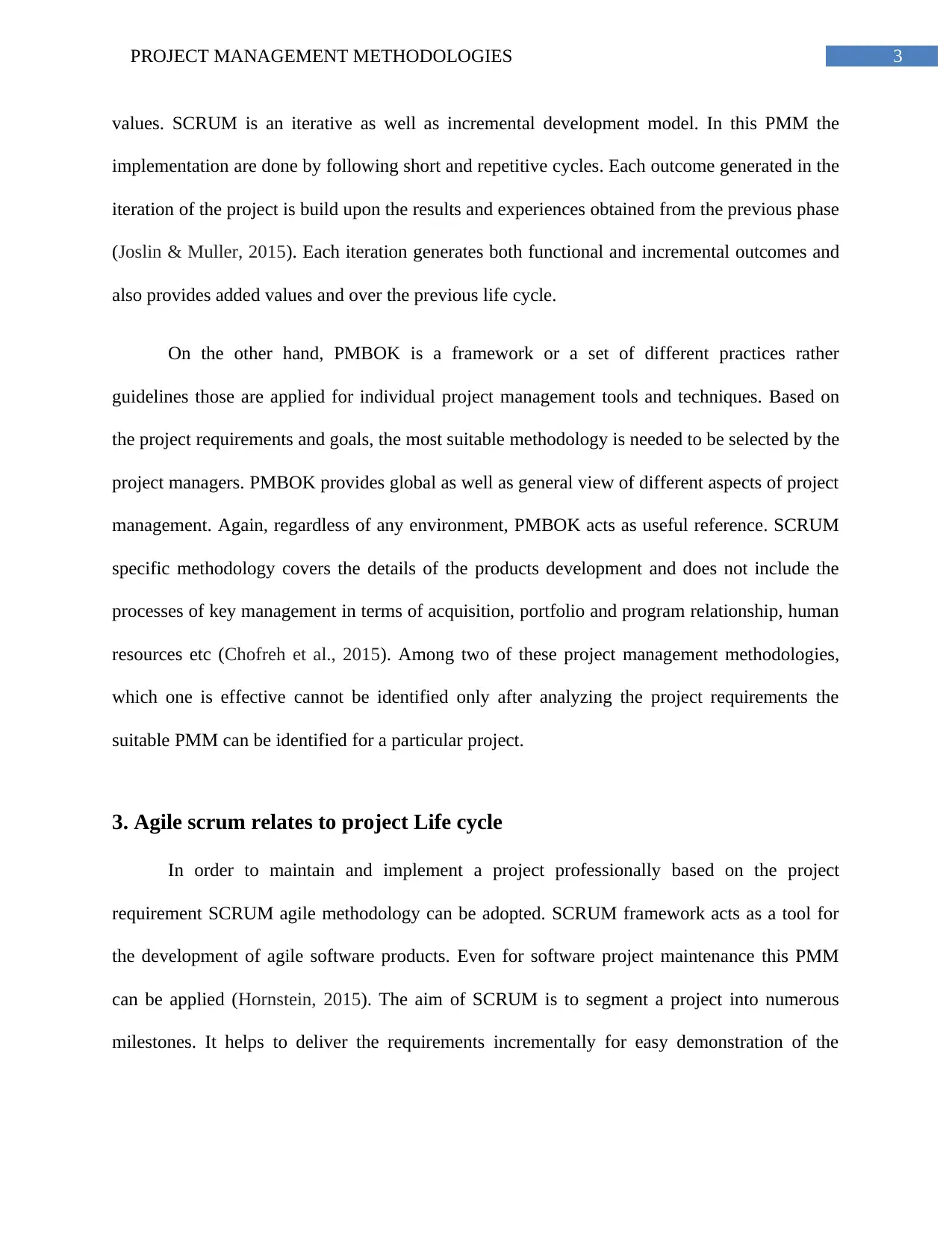
3PROJECT MANAGEMENT METHODOLOGIES
values. SCRUM is an iterative as well as incremental development model. In this PMM the
implementation are done by following short and repetitive cycles. Each outcome generated in the
iteration of the project is build upon the results and experiences obtained from the previous phase
(Joslin & Muller, 2015). Each iteration generates both functional and incremental outcomes and
also provides added values and over the previous life cycle.
On the other hand, PMBOK is a framework or a set of different practices rather
guidelines those are applied for individual project management tools and techniques. Based on
the project requirements and goals, the most suitable methodology is needed to be selected by the
project managers. PMBOK provides global as well as general view of different aspects of project
management. Again, regardless of any environment, PMBOK acts as useful reference. SCRUM
specific methodology covers the details of the products development and does not include the
processes of key management in terms of acquisition, portfolio and program relationship, human
resources etc (Chofreh et al., 2015). Among two of these project management methodologies,
which one is effective cannot be identified only after analyzing the project requirements the
suitable PMM can be identified for a particular project.
3. Agile scrum relates to project Life cycle
In order to maintain and implement a project professionally based on the project
requirement SCRUM agile methodology can be adopted. SCRUM framework acts as a tool for
the development of agile software products. Even for software project maintenance this PMM
can be applied (Hornstein, 2015). The aim of SCRUM is to segment a project into numerous
milestones. It helps to deliver the requirements incrementally for easy demonstration of the
values. SCRUM is an iterative as well as incremental development model. In this PMM the
implementation are done by following short and repetitive cycles. Each outcome generated in the
iteration of the project is build upon the results and experiences obtained from the previous phase
(Joslin & Muller, 2015). Each iteration generates both functional and incremental outcomes and
also provides added values and over the previous life cycle.
On the other hand, PMBOK is a framework or a set of different practices rather
guidelines those are applied for individual project management tools and techniques. Based on
the project requirements and goals, the most suitable methodology is needed to be selected by the
project managers. PMBOK provides global as well as general view of different aspects of project
management. Again, regardless of any environment, PMBOK acts as useful reference. SCRUM
specific methodology covers the details of the products development and does not include the
processes of key management in terms of acquisition, portfolio and program relationship, human
resources etc (Chofreh et al., 2015). Among two of these project management methodologies,
which one is effective cannot be identified only after analyzing the project requirements the
suitable PMM can be identified for a particular project.
3. Agile scrum relates to project Life cycle
In order to maintain and implement a project professionally based on the project
requirement SCRUM agile methodology can be adopted. SCRUM framework acts as a tool for
the development of agile software products. Even for software project maintenance this PMM
can be applied (Hornstein, 2015). The aim of SCRUM is to segment a project into numerous
milestones. It helps to deliver the requirements incrementally for easy demonstration of the
Paraphrase This Document
Need a fresh take? Get an instant paraphrase of this document with our AI Paraphraser
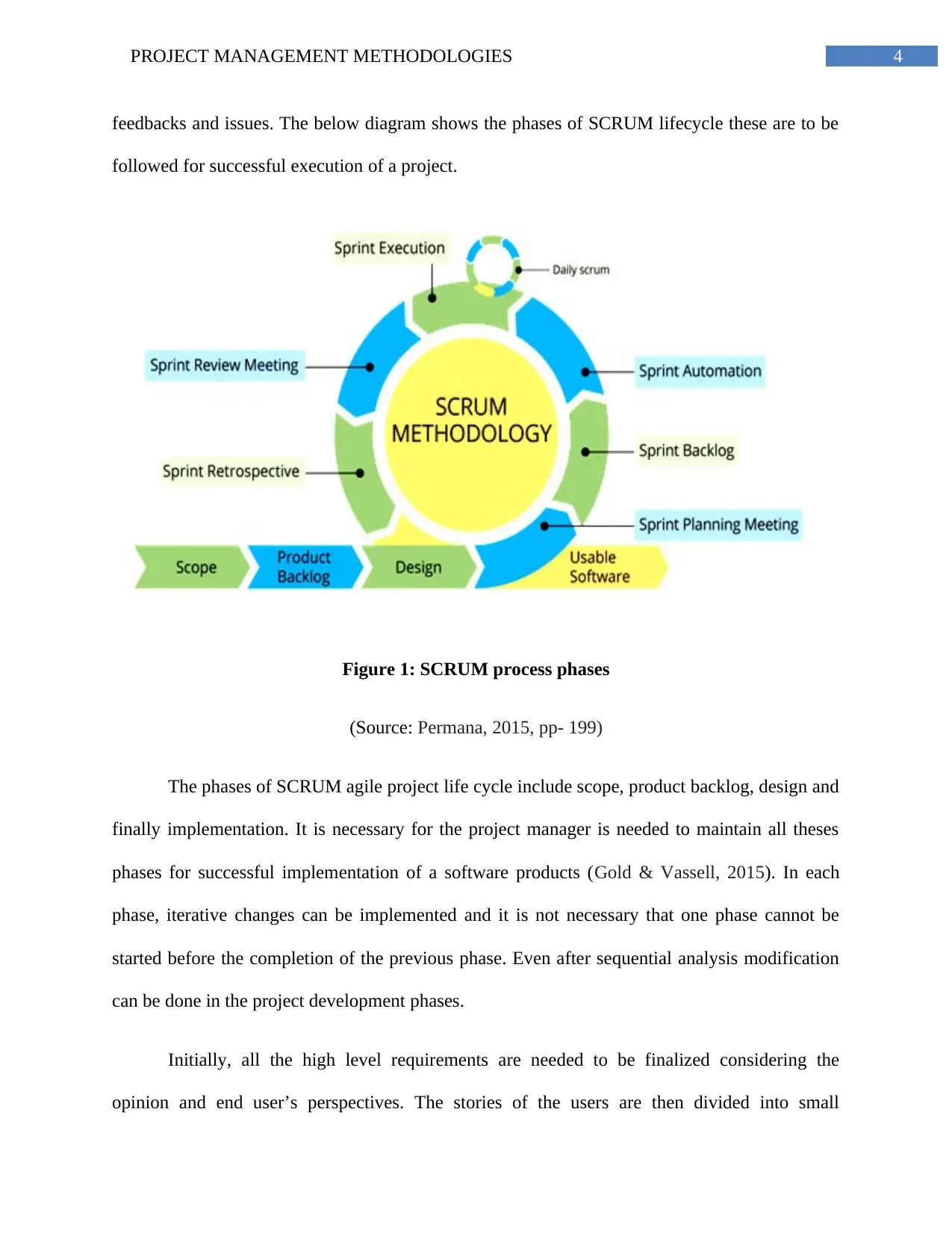
4PROJECT MANAGEMENT METHODOLOGIES
feedbacks and issues. The below diagram shows the phases of SCRUM lifecycle these are to be
followed for successful execution of a project.
Figure 1: SCRUM process phases
(Source: Permana, 2015, pp- 199)
The phases of SCRUM agile project life cycle include scope, product backlog, design and
finally implementation. It is necessary for the project manager is needed to maintain all theses
phases for successful implementation of a software products (Gold & Vassell, 2015). In each
phase, iterative changes can be implemented and it is not necessary that one phase cannot be
started before the completion of the previous phase. Even after sequential analysis modification
can be done in the project development phases.
Initially, all the high level requirements are needed to be finalized considering the
opinion and end user’s perspectives. The stories of the users are then divided into small
feedbacks and issues. The below diagram shows the phases of SCRUM lifecycle these are to be
followed for successful execution of a project.
Figure 1: SCRUM process phases
(Source: Permana, 2015, pp- 199)
The phases of SCRUM agile project life cycle include scope, product backlog, design and
finally implementation. It is necessary for the project manager is needed to maintain all theses
phases for successful implementation of a software products (Gold & Vassell, 2015). In each
phase, iterative changes can be implemented and it is not necessary that one phase cannot be
started before the completion of the previous phase. Even after sequential analysis modification
can be done in the project development phases.
Initially, all the high level requirements are needed to be finalized considering the
opinion and end user’s perspectives. The stories of the users are then divided into small
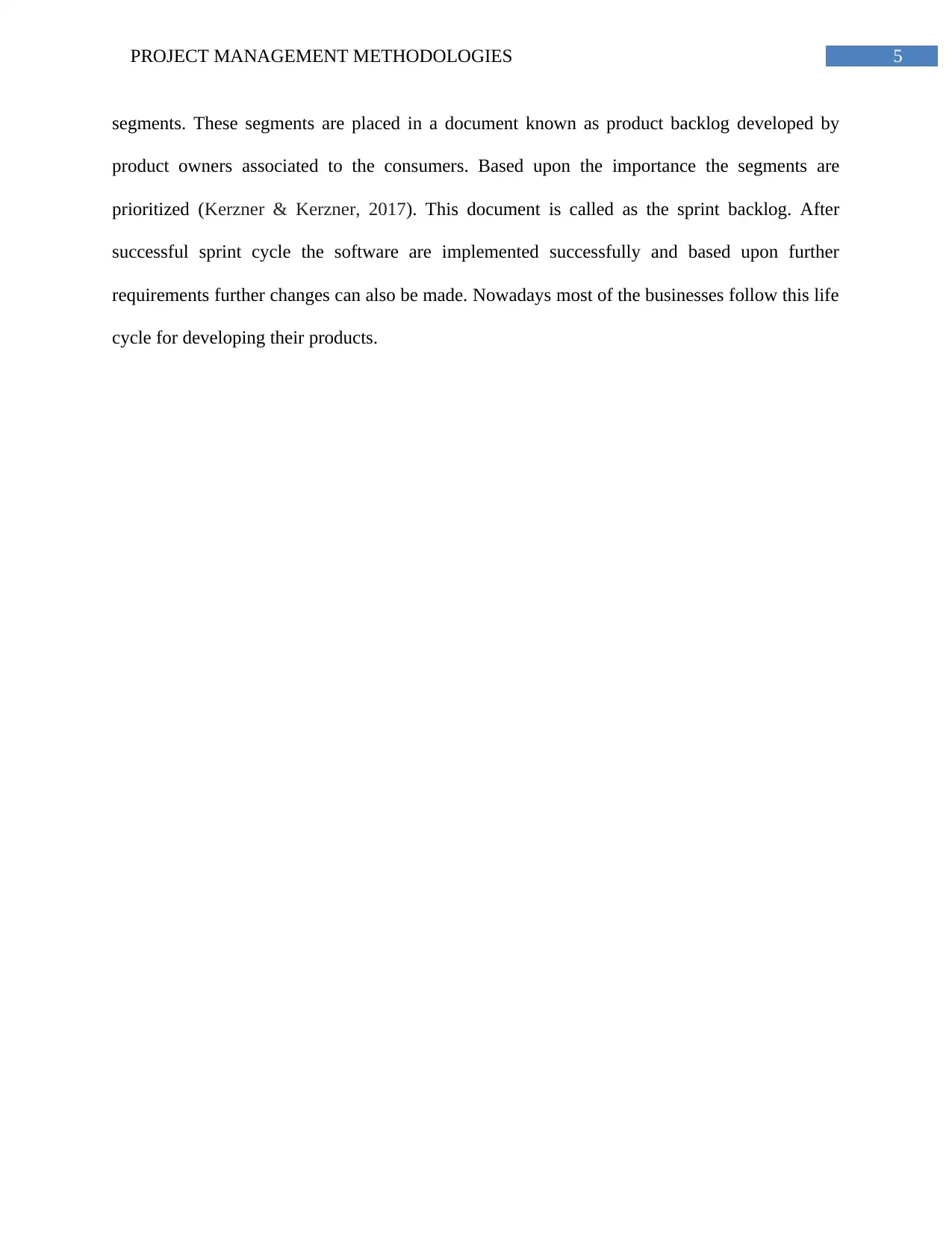
5PROJECT MANAGEMENT METHODOLOGIES
segments. These segments are placed in a document known as product backlog developed by
product owners associated to the consumers. Based upon the importance the segments are
prioritized (Kerzner & Kerzner, 2017). This document is called as the sprint backlog. After
successful sprint cycle the software are implemented successfully and based upon further
requirements further changes can also be made. Nowadays most of the businesses follow this life
cycle for developing their products.
segments. These segments are placed in a document known as product backlog developed by
product owners associated to the consumers. Based upon the importance the segments are
prioritized (Kerzner & Kerzner, 2017). This document is called as the sprint backlog. After
successful sprint cycle the software are implemented successfully and based upon further
requirements further changes can also be made. Nowadays most of the businesses follow this life
cycle for developing their products.
⊘ This is a preview!⊘
Do you want full access?
Subscribe today to unlock all pages.

Trusted by 1+ million students worldwide

6PROJECT MANAGEMENT METHODOLOGIES
References
Chofreh, A. G., Goni, F., Shaharoun, A. M., & Ismail, S. (2015). A review on sustainability
transformation roadmaps using project management methodology. Advanced Science
Letters, 21(2), 133-136.
Gold, B., & Vassell, C. (2015, November). Using risk management to balance agile methods: A
study of the Scrum process. In Knowledge-Based Engineering and Innovation (KBEI),
2015 2nd International Conference on (pp. 49-54). IEEE.
Hornstein, H. A. (2015). The integration of project management and organizational change
management is now a necessity. International Journal of Project Management, 33(2),
291-298.
Joslin, R., & Müller, R. (2015). Relationships between a project management methodology and
project success in different project governance contexts. International Journal of Project
Management, 33(6), 1377-1392.
Kerzner, H., & Kerzner, H. R. (2017). Project management: a systems approach to planning,
scheduling, and controlling. John Wiley & Sons.
Machado, T. C. S., Pinheiro, P. R., & Tamanini, I. (2015). Project management aided by verbal
decision analysis approaches: a case study for the selection of the best SCRUM
practices. International Transactions in Operational Research, 22(2), 287-312.
References
Chofreh, A. G., Goni, F., Shaharoun, A. M., & Ismail, S. (2015). A review on sustainability
transformation roadmaps using project management methodology. Advanced Science
Letters, 21(2), 133-136.
Gold, B., & Vassell, C. (2015, November). Using risk management to balance agile methods: A
study of the Scrum process. In Knowledge-Based Engineering and Innovation (KBEI),
2015 2nd International Conference on (pp. 49-54). IEEE.
Hornstein, H. A. (2015). The integration of project management and organizational change
management is now a necessity. International Journal of Project Management, 33(2),
291-298.
Joslin, R., & Müller, R. (2015). Relationships between a project management methodology and
project success in different project governance contexts. International Journal of Project
Management, 33(6), 1377-1392.
Kerzner, H., & Kerzner, H. R. (2017). Project management: a systems approach to planning,
scheduling, and controlling. John Wiley & Sons.
Machado, T. C. S., Pinheiro, P. R., & Tamanini, I. (2015). Project management aided by verbal
decision analysis approaches: a case study for the selection of the best SCRUM
practices. International Transactions in Operational Research, 22(2), 287-312.
Paraphrase This Document
Need a fresh take? Get an instant paraphrase of this document with our AI Paraphraser
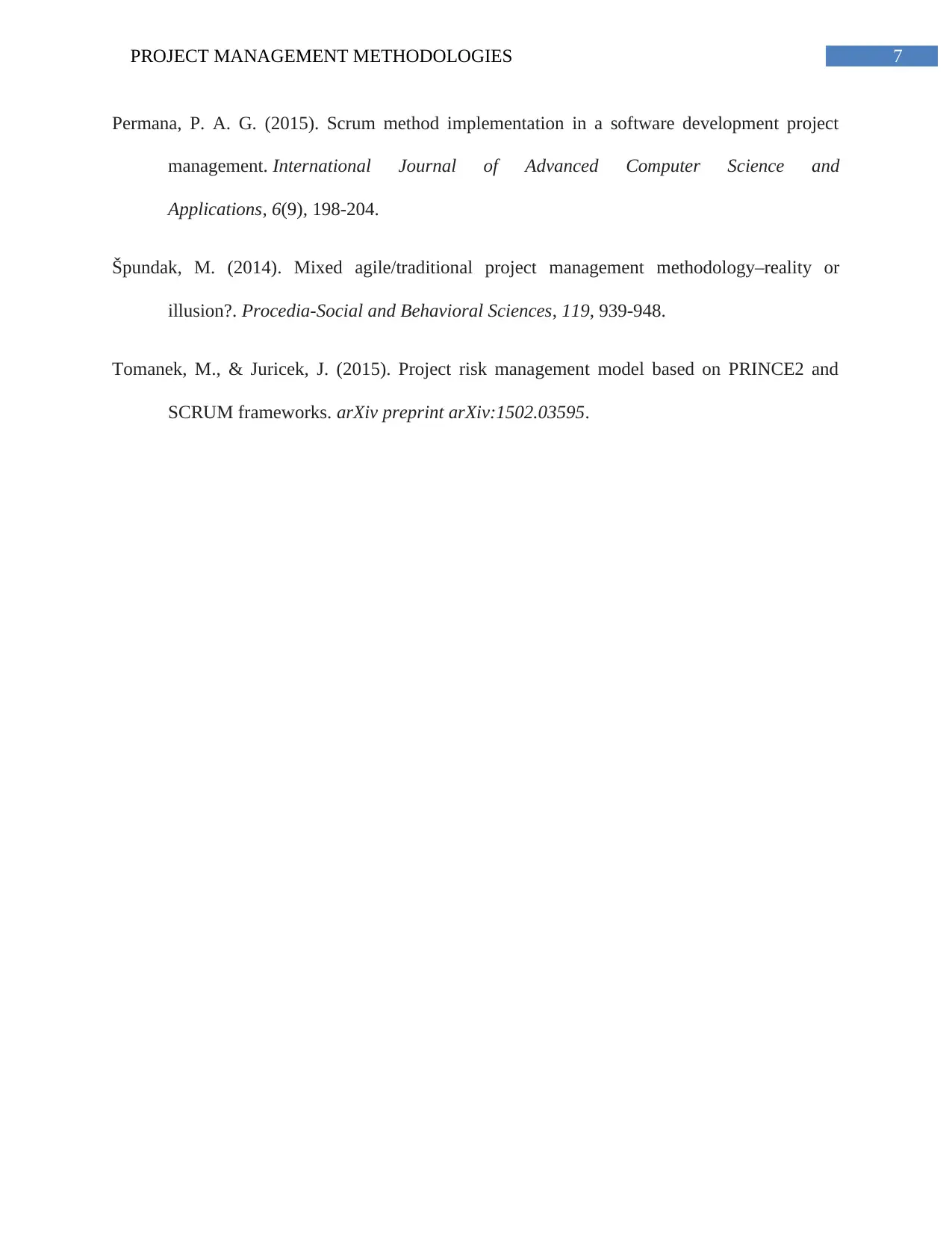
7PROJECT MANAGEMENT METHODOLOGIES
Permana, P. A. G. (2015). Scrum method implementation in a software development project
management. International Journal of Advanced Computer Science and
Applications, 6(9), 198-204.
Špundak, M. (2014). Mixed agile/traditional project management methodology–reality or
illusion?. Procedia-Social and Behavioral Sciences, 119, 939-948.
Tomanek, M., & Juricek, J. (2015). Project risk management model based on PRINCE2 and
SCRUM frameworks. arXiv preprint arXiv:1502.03595.
Permana, P. A. G. (2015). Scrum method implementation in a software development project
management. International Journal of Advanced Computer Science and
Applications, 6(9), 198-204.
Špundak, M. (2014). Mixed agile/traditional project management methodology–reality or
illusion?. Procedia-Social and Behavioral Sciences, 119, 939-948.
Tomanek, M., & Juricek, J. (2015). Project risk management model based on PRINCE2 and
SCRUM frameworks. arXiv preprint arXiv:1502.03595.
1 out of 8
Related Documents
Your All-in-One AI-Powered Toolkit for Academic Success.
+13062052269
info@desklib.com
Available 24*7 on WhatsApp / Email
![[object Object]](/_next/static/media/star-bottom.7253800d.svg)
Unlock your academic potential
Copyright © 2020–2025 A2Z Services. All Rights Reserved. Developed and managed by ZUCOL.





